Gorgeous gravel garden outshines former lawn in Lakewood garden
Whenever landscape architect Curt Arnette of Sitio Design invites me to see one of his gardens, I say, “I’ll be right there!” Last Saturday we toured a 1-year-old garden in the Lakewood neighborhood of West Austin that he designed and that his cousin John Gibson (of Gibson Landscape in Georgetown, Texas) installed. This is the street view — shazam!
I was lucky to catch at peak bloom the Gulf muhly grasses that run ribbon-like through the front garden. Sculptural succulents and woody lilies like Opuntia and Yucca rostrata anchor the garden when the muhly is not in bloom. Dense native groundcovers like frogfruit (Phyla nodiflora) and woolly stemodia (Stemodia lanata) keep it feeling lush despite the obvious drought tolerance of this well-drained gravel garden.
A green-trunked, thorny, native retama tree (Parkinsonia aculeata) adds height and chrome-yellow flowers in the spring. A wide view shows the winding layout of the front garden, which occupies a large corner lot.
BEFORE: This image from Google Maps gives you a sense of how much Curt changed with the new design. How boring is this huge, flat expanse of thirsty lawn, with a smattering of crepe myrtles and pines (in Austin!) along the circular drive? Curt kept some of the pines, which add height and texture and put me in mind of Bastrop’s pineywoods in the sandy soils to the east of Austin. He also specified a regrading of the lot (see photo above), creating large, bermed planting beds mulched in chunky granite gravel, with wide, curving paths of packed decomposed granite running through the garden.
Limestone boulders are placed artfully along the edges of the path. Notice how the boulders are buried halfway in the soil, giving them a natural look. Curt’s plant palette mixes native shrubs, perennials, and grasses with subtropical palms and flowering shrubs (like Tecoma ‘Orange Jubilee’) and desert plants like yuccas and agaves. The result is hybrid style that’s uniquely Austin.
Flowering aloe, with bamboo muhly (Muhlenbergia dumosa) and Gulf muhly (Muhlenbergia capillaris) in the background.
Chartreuse clouds of bamboo muhly frame a vase-shaped palm, red yuccas (Hesperaloe parviflora), and a ‘Whale’s Tongue’ agave (A. ovatifolia).
Another wide view, with silver ponyfoot (Dichondra argentea) carpeting the bermed bed at right. It’s beautiful now, but keep in mind that this is only a year-old garden, and the agaves will fill in to 4 or 5 feet across in the next few years. The palms will fill out as well, adding to the lushness.
Mexican olive (Cordia boissieri) in flower. I usually see these pruned up as trees, but I like the shrubby look too. (A sustained hard freeze can damage this beautiful South Texas native, so if you covet one it should be sited with care.)
The naturalistic style of the front garden gives way to a linear, more contemporary design as you reach a fenced courtyard garden that leads to the home’s entry. Curt designed the rust-colored, steel-mesh panels and arbor, which provide security, deer-proofing, and a sense of privacy without obstructing views or breezes. He also designed the raised steel container with a concrete pond inserted in the middle. Recirculating water flows from the pond into a raised, concrete rill that runs through a cut-out in the fence…
…leading the eye into the courtyard garden and toward a large, circular pond. A path of poured-concrete strips, both aggregate and smooth-surfaced, leads you into the garden, but not too quickly. You are encouraged to linger over the plants that grow in crevices along the path and soften the geometry of the hardscaping. The freckled, fleshy leaves of ‘Macho Mocha’ mangave spill over the path’s edge at right.
I love this evergreen combination of bamboo muhly, firecracker fern (Russelia equisetiformis), and some variety of palm, with Yucca rostrata anchoring the corner.
The rill pours neatly into the sunken pool…
…home to a couple of water lilies and a school of colorful fish. Observant readers may remember a similar pond in Curt’s own garden, which he described as a trial run for this one.
To the right, a shoestring acacia (A. stenophylla) with a graceful weeping form anchors the small garden by the fence. Native to Australia, this small tree is said to be hardy to 20 F. (Austinites, plant with care, giving it a protected location and a southern exposure.)
A trio of Yucca rostrata of varied heights, with their shimmering Koosh-ball heads, stand sentinel by a side entrance.
A wider view shows a change in elevation to the left of the pond, which gives the courtyard even more of a sense of enclosure.
A side view. The home’s double front doors are visible at right. Notice the circular strip of aggregate concrete running around the pond, emphasizing its shape, adding a sense of movement, and leading the eye.
Steel edges steps and a raised bed behind the garage, with a stacked-antler sculpture adding a focal point that plays off the yuccas’ spiky forms. Silver ponyfoot cascades over the steel edging.
A closer look
Behind the garage, a metal mesh gate opens up a stuccoed wall and offers a view of the front garden.
Here’s the other side, if you’re curious. Curt designed all the metalwork in the garden as well.
‘Whale’s Tongue’ agave (A. ovatifolia) mingling with Gregg’s mistflower (Conoclinium greggii)
Leaving the courtyard, you step up into the back garden — a large side garden, really, as the back of the house overlooks a canyon leading down to Bull Creek. Casual decomposed-granite paths lead through a shady space with a naturalistic yet uncluttered style.
Agave and a yaupon holly, laden with golden berries. The yellow-berried yaupon is rarer to see than the standard red-berried one.
Philippine violet (Barleria cristata) in full purple bloom
The back garden is laid out in a similar fashion to the front garden, only with smaller bermed and graveled beds, and with shade-tolerant plants instead of sun-loving. Winding paths of decomposed granite invite you to explore. This is the view looking back toward the courtyard entry garden.
Notice that no edging separates paths from planting beds, although a chunkier gravel is used to mulch the plants than is used on the paths. In the narrow strip along the back of the house, a swimming pool with a raised edge and surrounding patio offers a place to entertain or lounge, and it overlooks a scenic view of Bull Creek.
The view from the pool patio is slightly more tropical, with clusters of palmetto, sago palm, philodendron, and lily-of-the-Nile or amaryllis.
The stucco wall that encloses the back garden is shorter behind the pool, where it’s topped with mesh fencing panels that allow light and views. That’s Bull Creek below, and a view of the surrounding hills.
Behind the master bedroom, a small patio offers an inviting spot for morning coffee.
The soft-yellow bloom spikes of forsythia sage (Salvia madrensis)
We exited the garden the same way we entered, through the entry courtyard. One last look…
Back out front, I had to admire the Gulf muhly again, and a wavy prickly pear.
Not to mention the overall scene
Even the mailbox is cool, done up in board-formed concrete. (The rill in the courtyard is constructed of board-formed concrete too. Scroll up for a photo.)
The garden tour wouldn’t be complete without a photo of the talented people who brought this garden to life: Curt Arnette, the designer, and John Gibson, the installer. And my thanks to the owners for allowing me to share their gorgeous, water-saving garden!
__________
UPCOMING APPEARANCES & BOOK-SIGNINGS
- Saturday, November 2, 1:00-2:00 pm — Antique Rose Emporium’s Fall Festival, Brenham, Texas
- Sunday, November 3, 2:00-3:00 pm — It’s About Thyme Garden Center, 11726 Manchaca Rd., Austin
Both events are free, and I’ll be selling and signing copies of Lawn Gone! I’d love to see your friendly faces!
All material © 2006-2013 by Pam Penick for Digging. Unauthorized reproduction prohibited.


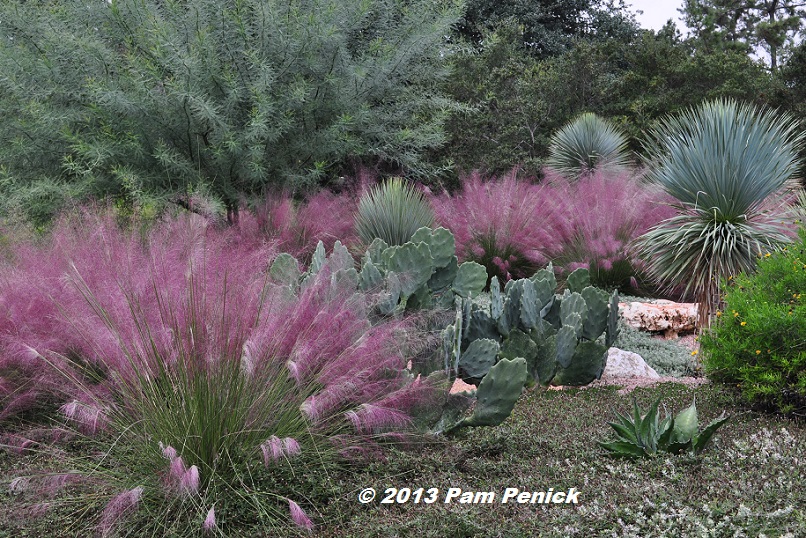
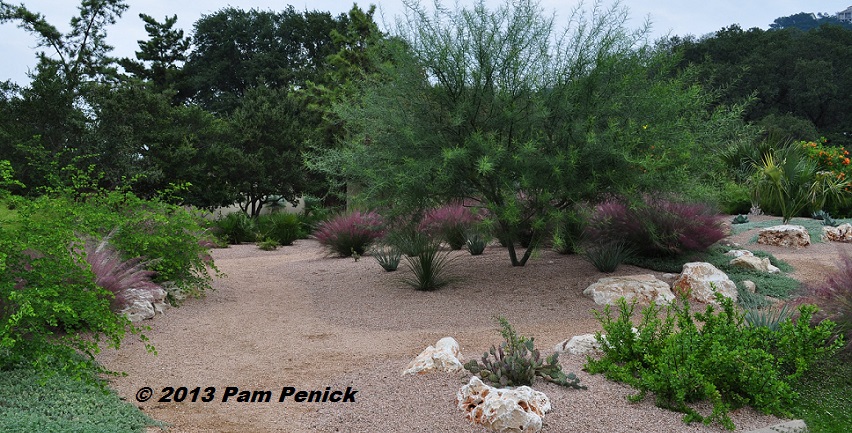
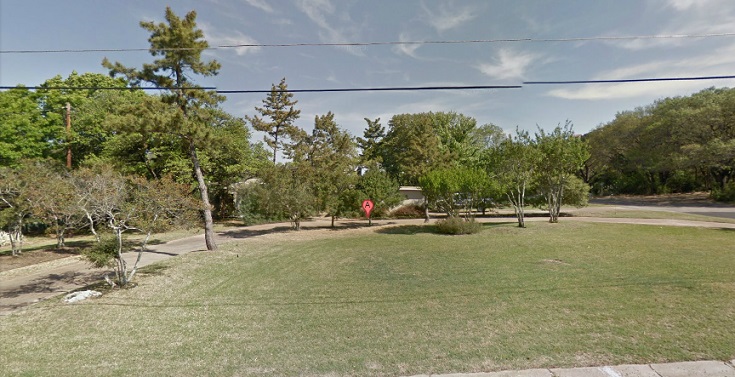
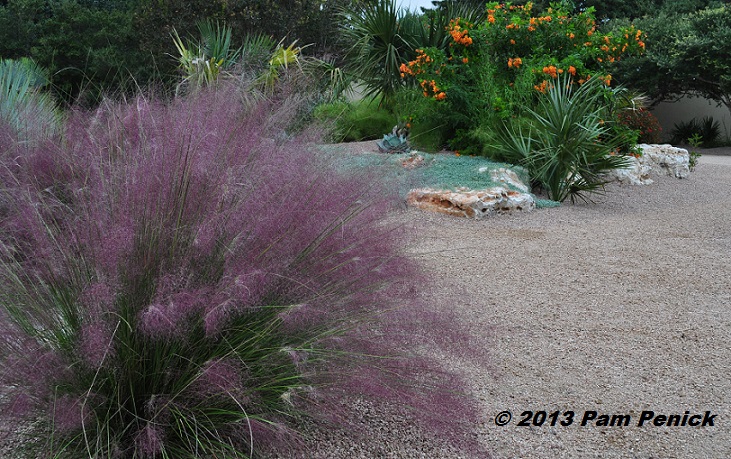
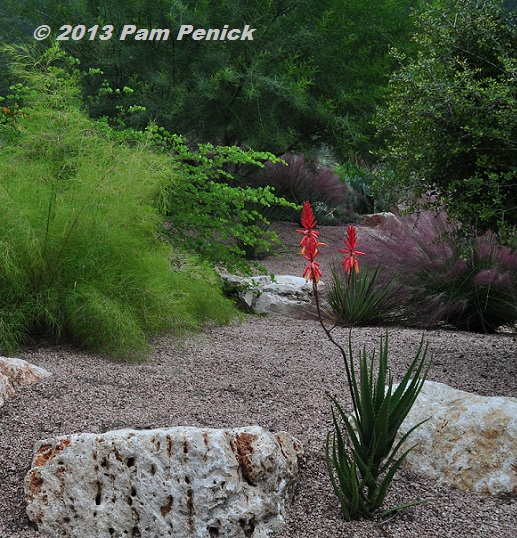
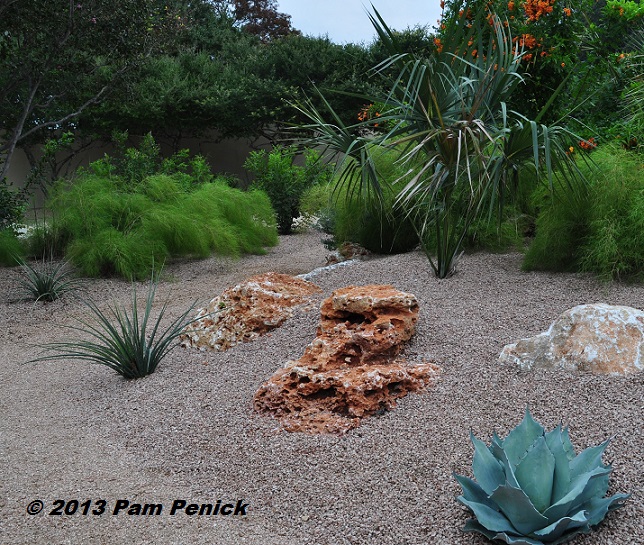
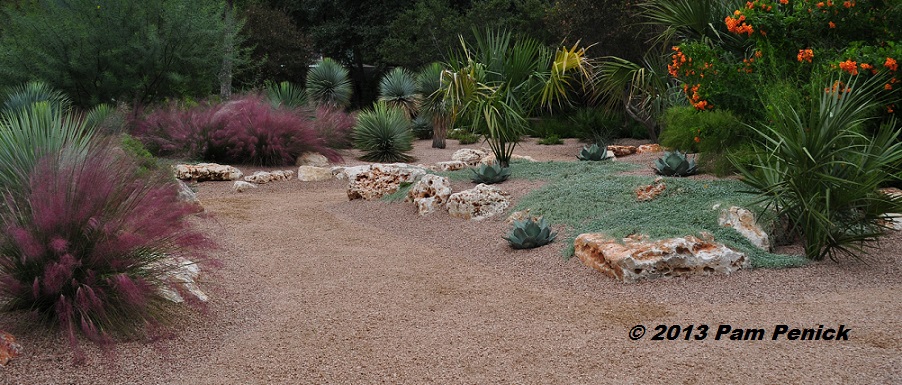
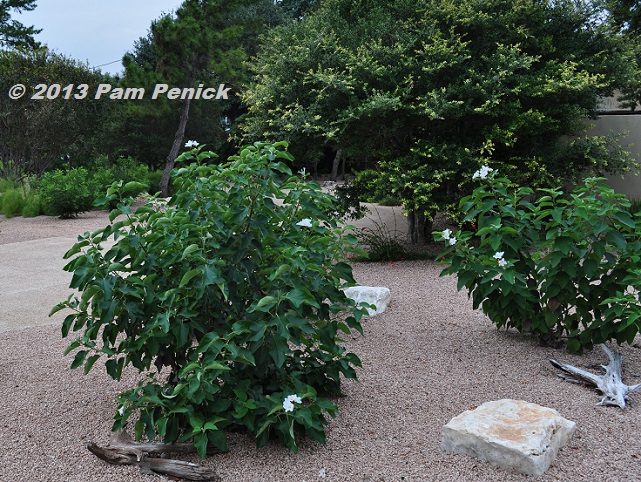
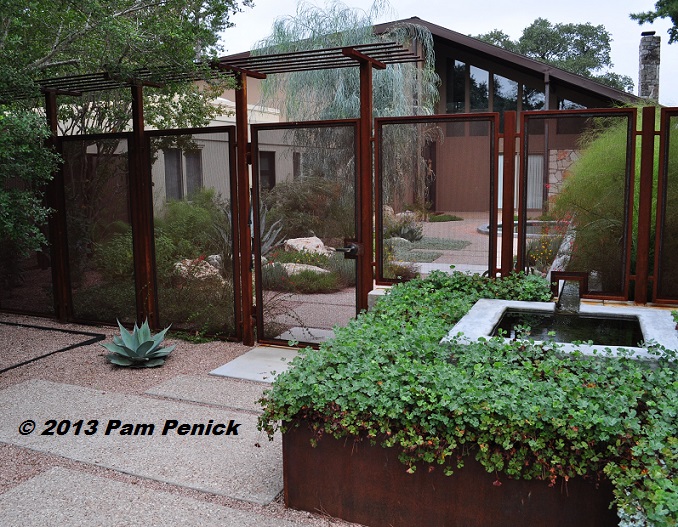
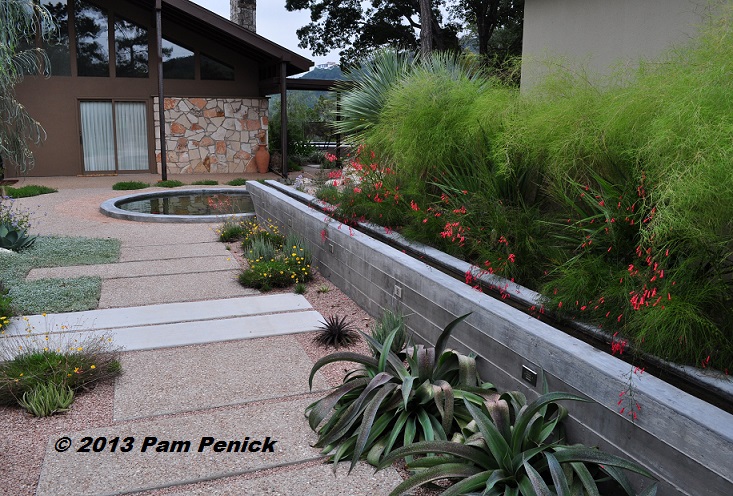
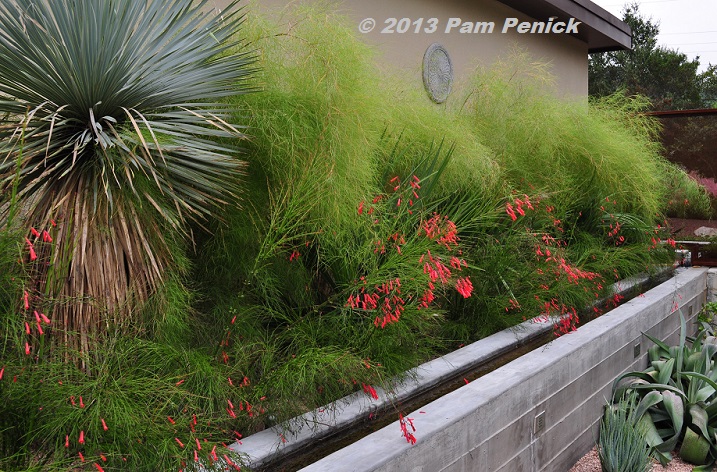
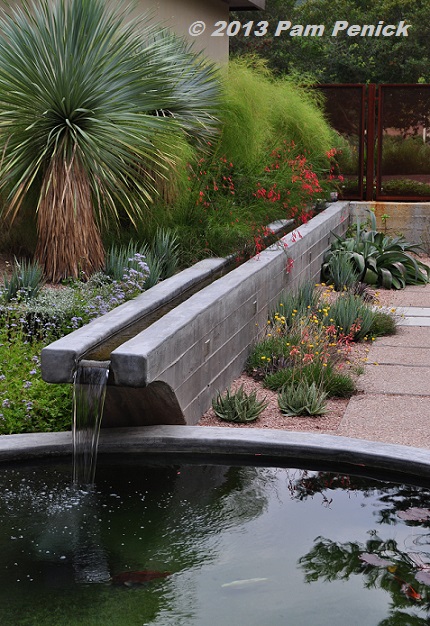
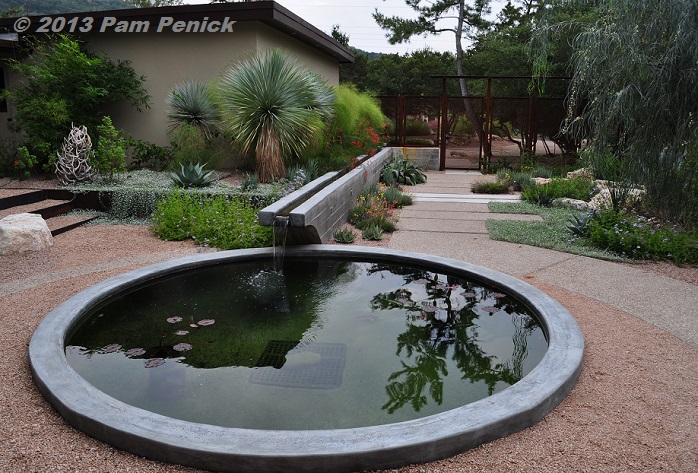
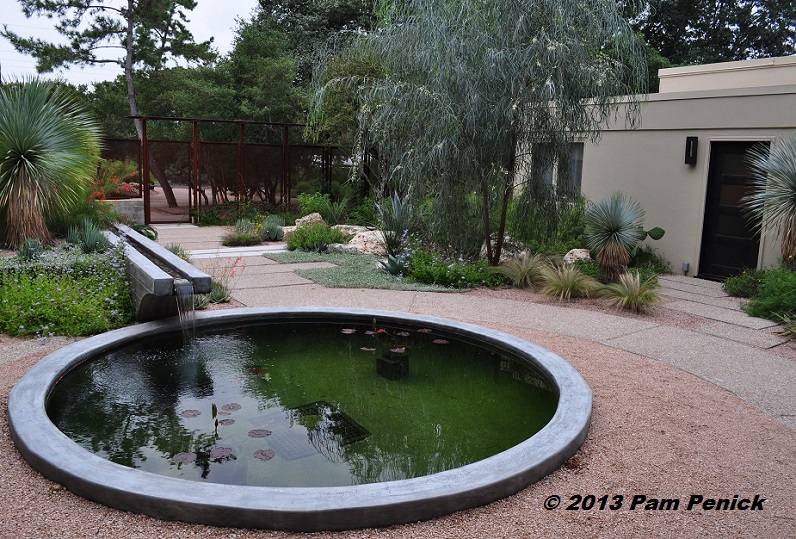
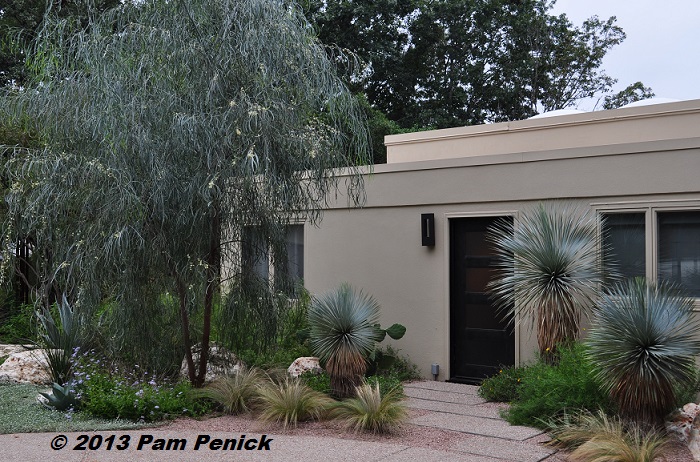
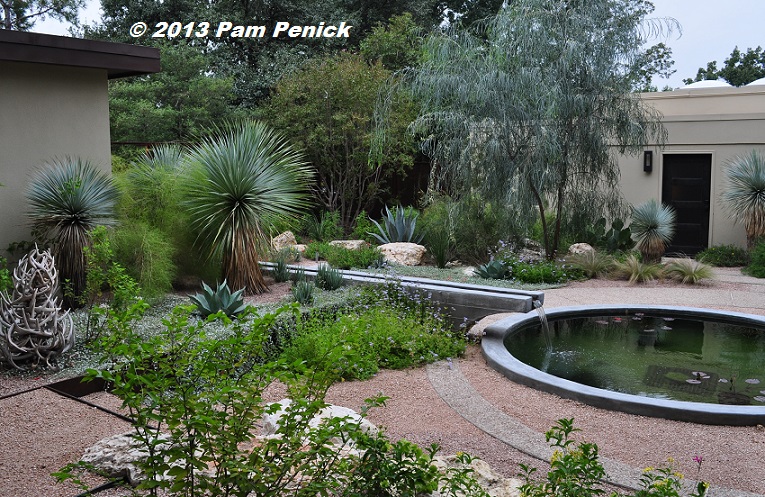
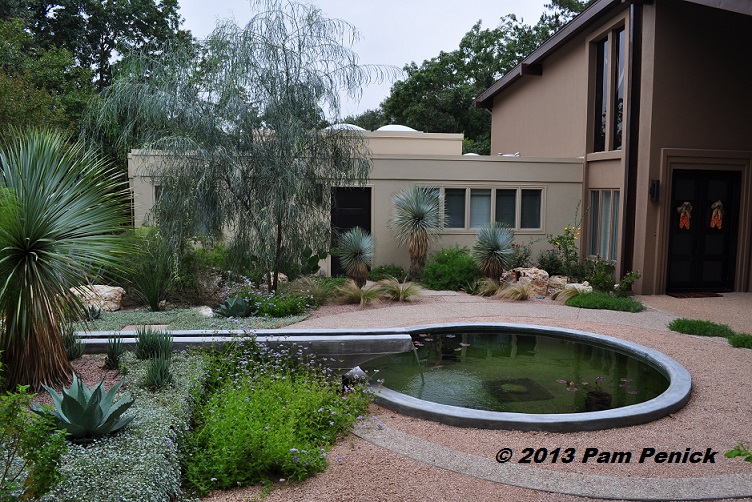
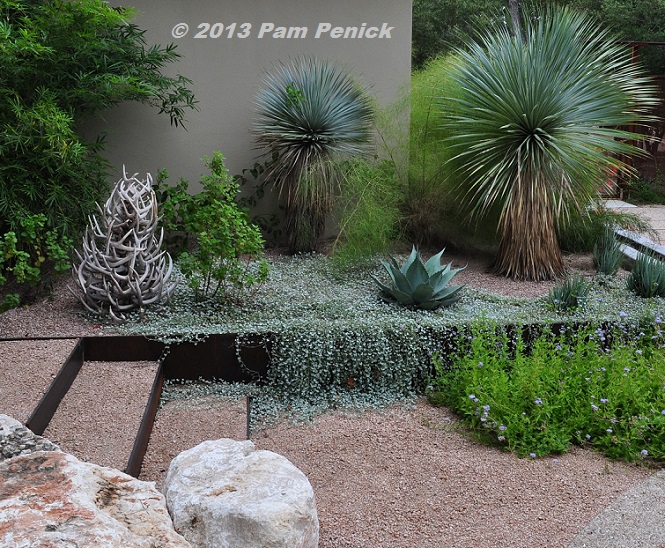
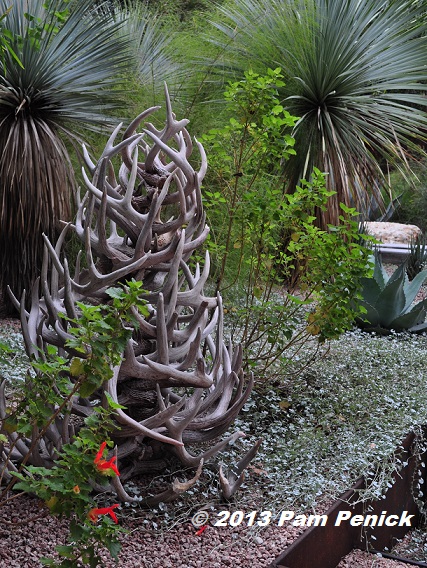
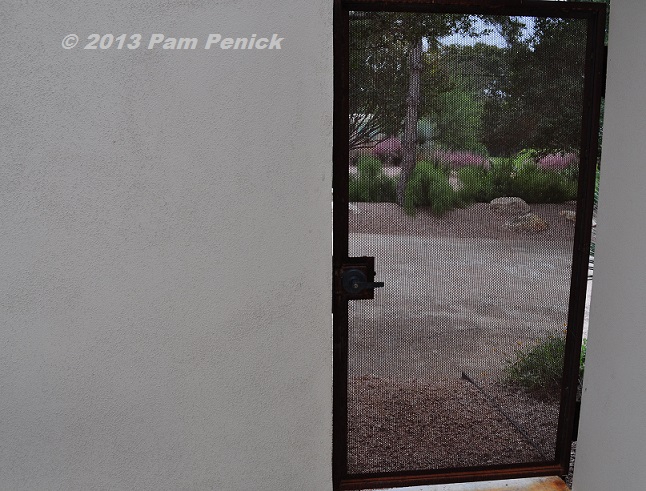
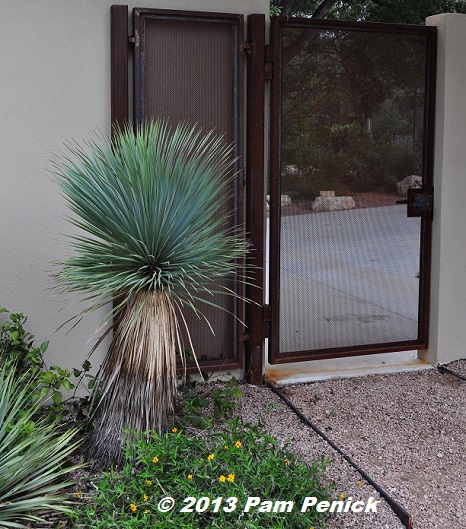
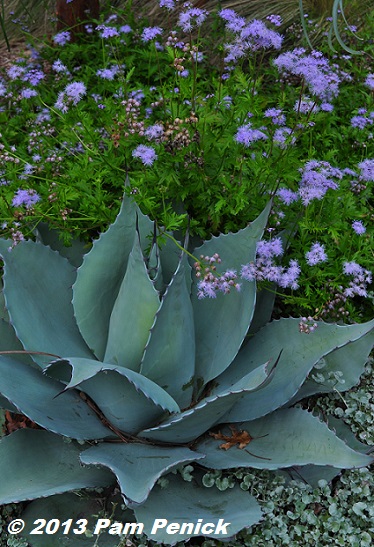
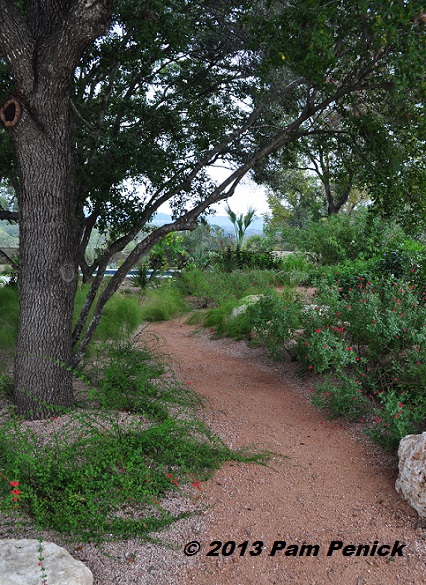
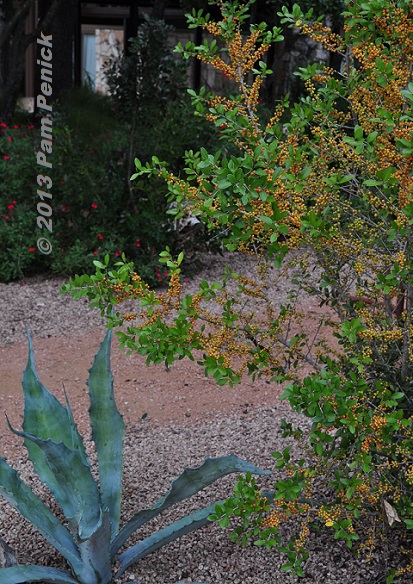
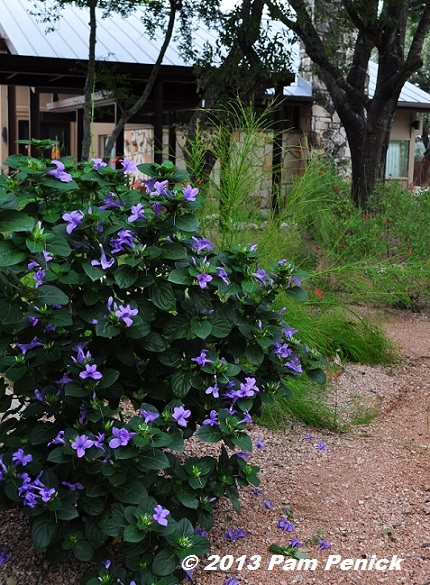
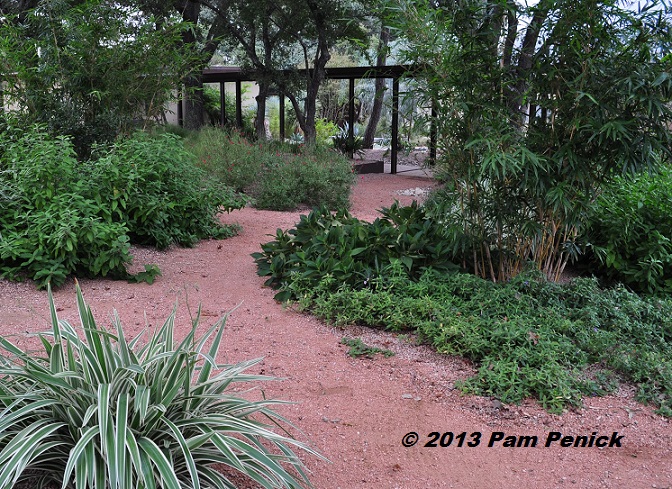
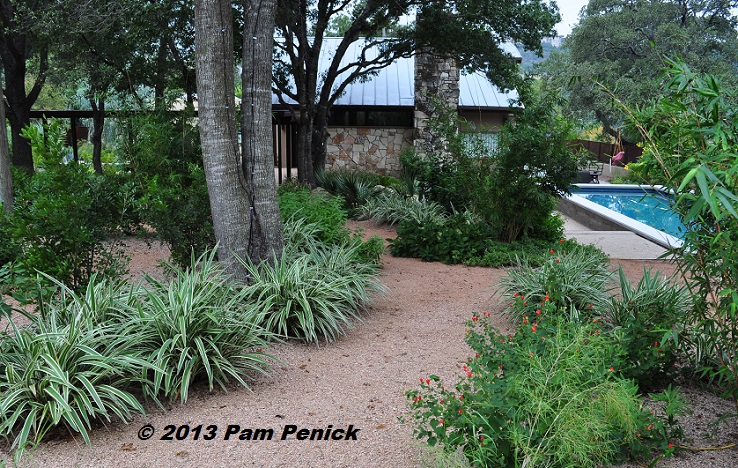
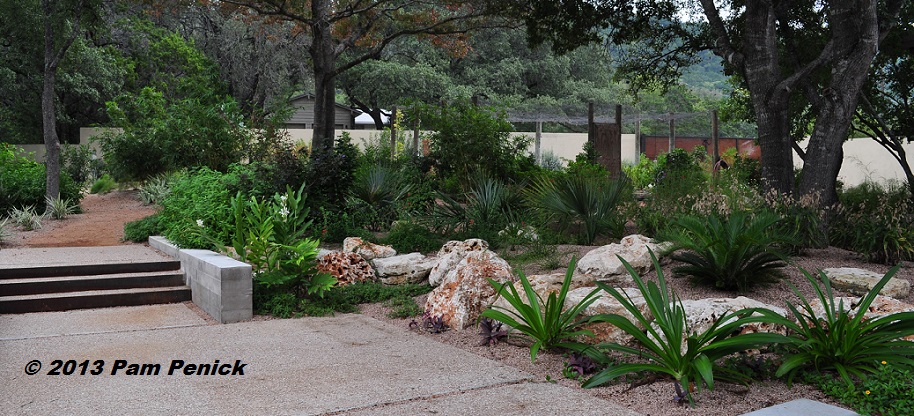
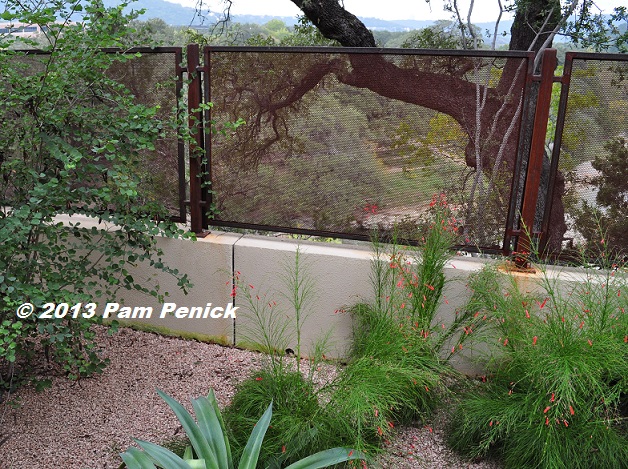
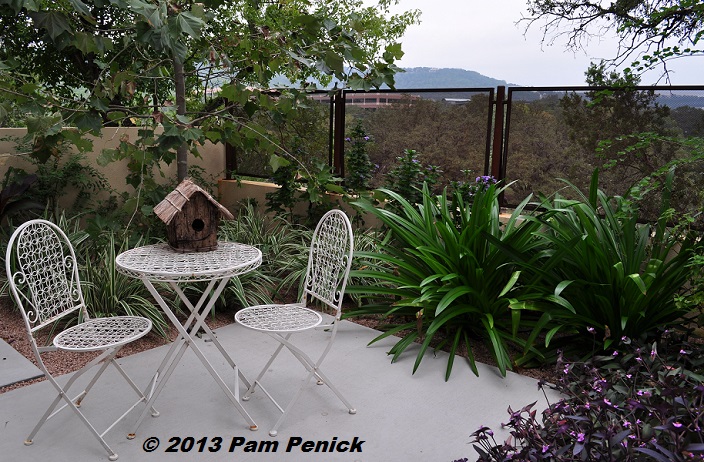
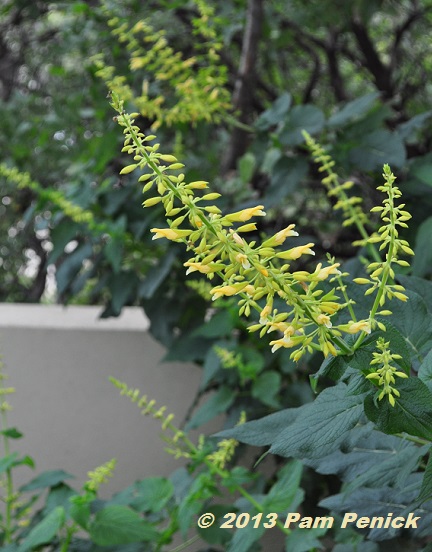
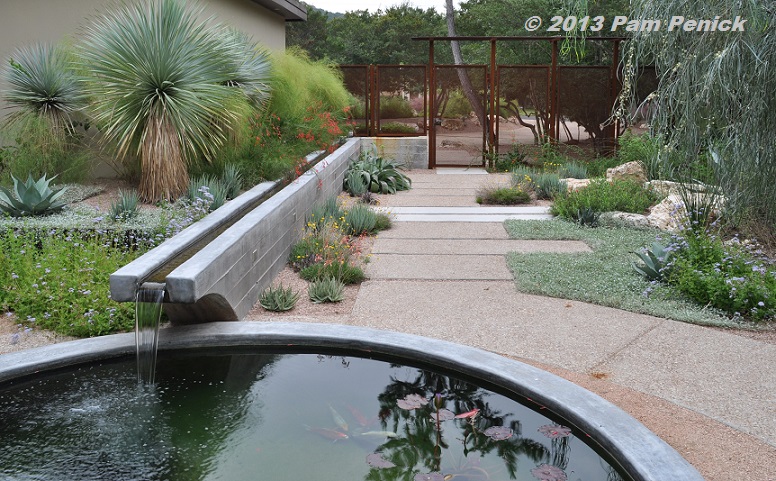
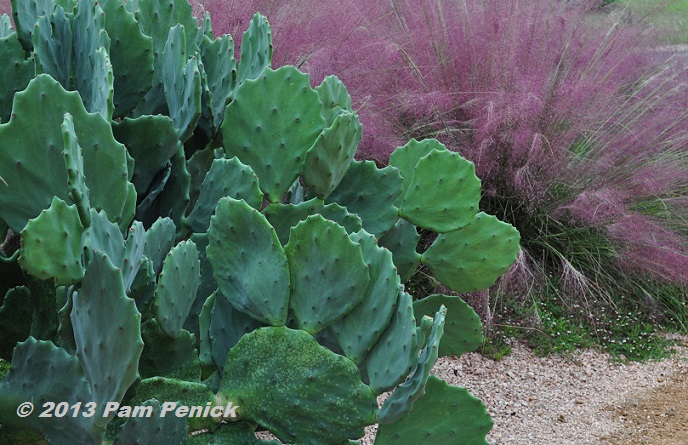
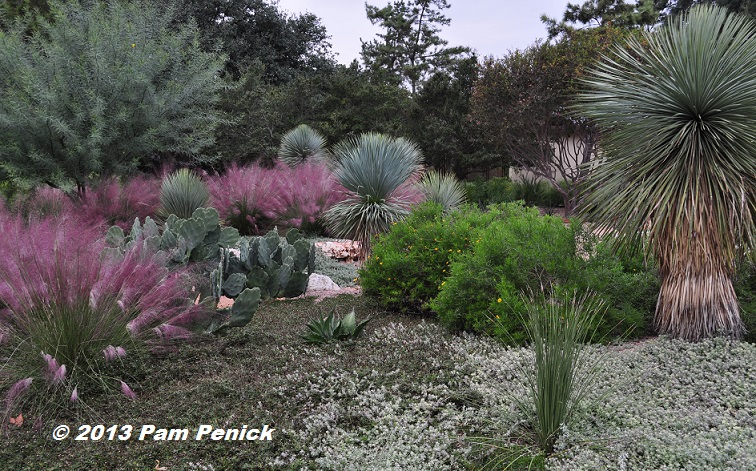
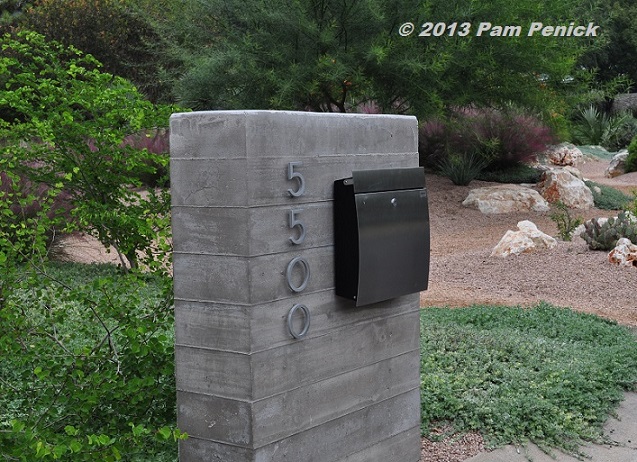
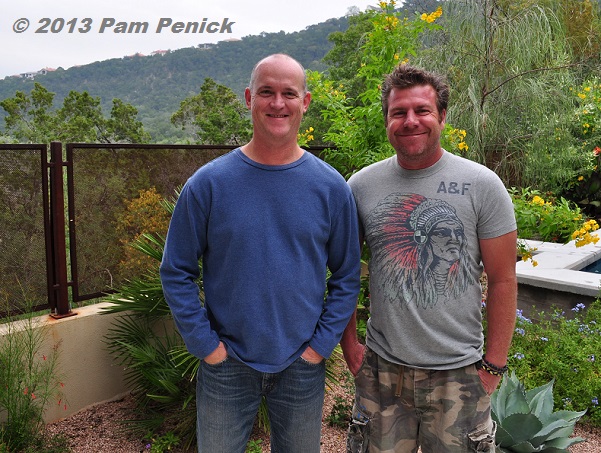
WOW…how nice that you actually got to go there and feast your eyes on this fabulous garden.
That’s a great garden to demonstrate how much beauty can be created using plants with low water needs. Your pictures do it justice.
So amazingly beautiful. You guys have so many nice plants available to you. I see lots that would grow in the low desert, but not really thrive. And lots that would just wilt away…
WOW! What a nice and beautifully designed space. Almost all of these plants are unknown to me, but it looks lovely.
That is a gorgeous garden. I think I will come back to this page time and time again to drink in all the design ideas. I think I need to spend a little more money on plants! 4″ pots are never going to achieve this look.
This is only a year old?? WOW! They did a fabulous job.
Lots of good ideas here. Thanks for taking us along.
Thank you for the picture-tour of this beautifully designed landscape! I love the integration of varying sizes of mineral mulch, natural rocks, wood-formed concrete, along with the beauty and variety of plants in different heights, texture, and color.
Question: How do they keep the mineral mulch in place in heavy rains? I’ve seen so much wash-out of decomposed granite all over Austin that it’s giving this mulch a bad rap. Sadly, the washed-out granite ends up causing skid hazards for drivers and bicyclists and ends up in our waterways. So, as a landscape designer with an emphasis on ecological design, I’m really interested in learning how he’s able to use the un-edged mineral mulch this successfully.
By the way, I have your book. Thank you making this resource available to everyone!
Your question about keeping gravel mulch in place on berms is a timely one in light of the fact that some areas of Austin got 8 or 9 inches of rain yesterday, with flooding all over town. I can’t answer this for Curt, though maybe he will if he reads it. For my own purposes, I find that decomposed granite paths stay put with the use of terracing and if water is not streaming across it like a river. —Pam
Yep, you nailed it – Shazam! Drooled all over my keyboard. Thanks for these exceptional photos and a fabulous tour!
I can never keep my composted granite and gravel areas this clean of leaves and debris, especially this time of year. Must take almost constant attention? Really would love mine to be this clean!
I expect this garden may have received a little “fluffing” since I was there to take portfolio pictures for Curt. It’s easier to keep gravel clean when you use yuccas, palms, and other non-debris-producing plants, as in this front garden. Under trees, as in the back? You’ve got to be relaxed about it. —Pam
I feel like this guy can only win. Love everything he touches.
What a fabulous garden. Thanks for sharing it. It starts my creative juices percolating as to how I can take one or two elements I’ve seen and use it in my garden.
Wow, talk about talking it up a notch. I love the mesh fence! The plants used look amazing. Wonderful composition. Stellar job!!
Wow! It is so beautiful so rrI am planning to keep this pictures on my next trip to nursery and look for the plants as on pictures.This is really Art of landscaping design,very inspiring garden,thank you Pam for give us the chance to see it.
Pam, you bring so much beauty into my life via your blog. I only wish I could see such sights in person.
CheyDesignGuy
Thanks for your kind words, Mitchell. Curt’s gardens appear on Austin garden tours from time to time, so if you’re a tour regular, especially of the Wildflower Center’s Gardens on Tour and the Garden Conservancy’s Open Days tour, you’ll probably see some of the gardens I post about. —Pam
One word, stunning, is all I can manage. That courtyard entryway, wow. (OK, that’s two words, stunning and wow.)
You really get to go to the best places. What an incredible garden, not a weed in sight, nor a stone out of place, and a fantastic piece of design.
I do get pretty lucky with garden tours. 😉 —Pam
WOW. Amazing. Thanks for sharing.
Amazing. Design of the metal work is simply inspired.
I fell in love with shoestring acacias after seeing them on several of your blogs. Is there any information on how they fared during the 2013/14 cold winter? I’m in San Antonio and purchased one today, but it can be returned. Hoping I don’t have to!
Thank you.
Ragna
I am curious about that myself, Ragna, but don’t know the answer. If I find out I’ll let you know. —Pam
Thanks Pam, that would be great. One bit of good news is that Heather (zericstyle) reported that the shoestring acacia planted in her San Antonio garden came through the winter just fine.